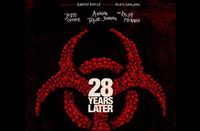After years of speculation and anticipation, Danny Boyle and Alex Garland’s much-awaited sequel, 28 Years Later, has finally landed on Netflix, drawing both diehard fans and a new generation of viewers into its harrowing, post-apocalyptic vision. Released to streaming in late September 2025, the film has already made a significant impact, grossing an impressive $150 million worldwide and earning the distinction of being the third highest-grossing horror movie of the year, according to Bloody Disgusting. For many, it’s not just a return to a beloved franchise, but also a comeback for Boyle himself, whose recent projects had struggled to find similar resonance.
The story picks up, as the title suggests, twenty-eight years after the original outbreak of the rage virus—a catastrophic event that first unfolded in the 2002 classic, 28 Days Later. In this new chapter, the United Kingdom has been completely overrun by the infected, leading to a harshly enforced quarantine that has lasted nearly three decades. Survivors now cling to life in fortified enclaves, their societies regressing to a state that, as Epigram describes, feels like “the rules and optics of society have been set back a good 800 years.” Life, however, finds a way. Isolated communities have adapted, establishing their own rules and hierarchies as they wait out the threat that never truly subsides.
At the heart of 28 Years Later is an intimate family drama set against this bleak backdrop. The main characters—Jamie (Aaron Taylor-Johnson), his wife Isla (Jodie Comer), and their 12-year-old son Spike (Alfie Williams)—live on Holy Island, a remote tidal island off the coast of Northumberland. The family’s existence is defined by seclusion and routine, with Spike having grown up entirely isolated from the mainland and the horrors that lurk beyond. When Isla is diagnosed with a terminal illness, Spike is forced to leave the safety of his home for the first time, embarking on a perilous journey to save his mother. This coming-of-age quest, as Epigram notes, serves as the film’s emotional core and delivers an “epic, emotional coming-of-age journey.”
The film’s narrative is both fragmented and ambitious, weaving together themes of survival, societal regression, and the enduring nature of humanity. Boyle and Garland use the zombie apocalypse not merely as a spectacle, but as a lens through which to examine deeper questions about resilience and adaptation. In the words of Epigram, “the chaos of an apocalypse isn’t the end point of humanity, but instead a mere stepping stone that we must get around to find our way back to how we lived before.” The story even draws unintentional parallels to the real-world pandemic experience, highlighting how societies, even after catastrophic disruption, inevitably seek to rebuild and move forward.
For those wondering about connections to the original film, 28 Years Later stands largely on its own. None of the original cast members reprise their roles, though rumors swirl about a possible future appearance by Cillian Murphy—who played Jim in the 2002 film—in the upcoming sequel. This independence makes the film accessible to newcomers, while still offering plenty for longtime fans. The renewed interest in the franchise has even boosted streaming numbers for 28 Days Later, which is now available alongside its sequel on platforms like Netflix, Apple TV, and Prime Video.
Yet, the film hasn’t been without its quirks and controversies. One of the more lighthearted moments came when fans, upon seeing the trailer, mistook a particularly gaunt zombie for Cillian Murphy’s character Jim. The internet buzzed with theories, only for it to be revealed that the zombie was actually played by Angus Neill. Murphy himself addressed the comparison with trademark dry wit, saying, “That’s great, people think I look like a zombie cadaver. It’s very flattering,” as reported by The Observer. His sons had shown him the viral image, and he took the attention in stride, adding a touch of humor to the film’s otherwise grim atmosphere.
Critics have praised the film’s performances, particularly Alfie Williams’ portrayal of Spike, which anchors the narrative’s emotional stakes. Ralph Fiennes also joins the cast, adding further gravitas to the ensemble. According to Bloody Disgusting, the film “builds on 28 Days Later with groundbreaking new techniques, rich worldbuilding, and dense themes,” making it a worthy successor that both honors and expands the original’s legacy.
The film’s structure, however, has divided some reviewers. While the central road trip premise offers a straightforward path through the chaos, Alex Garland’s script often veers into unexpected territory, introducing intriguing concepts—pregnant zombies, bands of ruthless zombie hunters, and a culture seemingly frozen in time—only to move on before fully exploring them. As Epigram observes, Garland has a tendency to “dangle the concepts… in front of the audience, only to snatch it away in favour of the next thing further down the line.” Despite this, the film’s third act delivers a powerful emotional resolution, with striking imagery—such as a towering column of human skulls—leaving a lasting impression.
For Indian audiences, 28 Years Later became available for streaming on Netflix India on September 20, 2025, and can also be rented or purchased on Prime Video and Apple TV, as reported by The Economic Times. The film’s release has rekindled enthusiasm for the original, with 28 Days Later trending again across streaming platforms. This accessibility has broadened the franchise’s reach, introducing it to new viewers and reaffirming its status as a touchstone of modern horror.
Looking ahead, fans have even more to anticipate. The second installment in the new trilogy, 28 Years Later: The Bone Temple, is set for theatrical release on January 16, 2026, with Nia DaCosta (of Candyman fame) taking the director’s chair. While details remain tightly under wraps, the promise of further exploration into this richly imagined world has already generated considerable buzz.
In an era crowded with formulaic sequels and reboots, 28 Years Later stands out as a rare franchise film that bears the unmistakable fingerprints of its creators. As Epigram puts it, “it’s almost impossible not to appreciate this rare franchise film that actually bears the fingerprints of its filmmaker—and I’ve really missed Danny Boyle’s fingerprints.” For fans old and new, the return of this franchise is not just a nostalgic trip, but a bold step forward in the evolution of cinematic horror.






